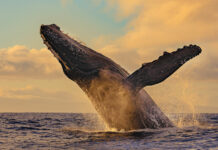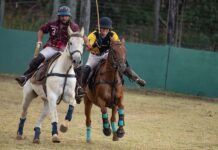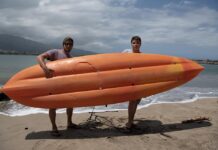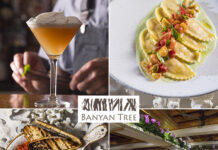Tom Stevens | Photography courtesy of Maui County Fair Nagamine Photo Studio Sunshine Orchids | Photography courtesy of Maui County Fair, Nagamine Photo Studio, Sunshine Orchids
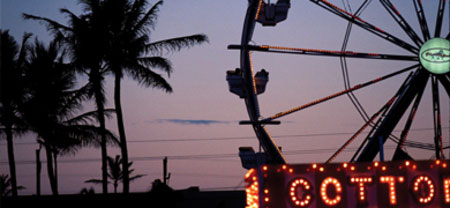 Google has a feature that simulates a warp-speed descent to our planet. If I could “Google Earth” to the Maui County Fair, I’d zip down from space at night, find Maui in the slumbering bulk of the Pacific, then streak toward the pinwheeling lights and colors of the fair.
Google has a feature that simulates a warp-speed descent to our planet. If I could “Google Earth” to the Maui County Fair, I’d zip down from space at night, find Maui in the slumbering bulk of the Pacific, then streak toward the pinwheeling lights and colors of the fair.
Moving this fast would also let me travel through time. I’d know I’m locked onto the fair when blurry images of bygone horse races, polo matches and celebrated high-school football games flicker past the view port.
I might glimpse elegant pa‘u parade riders from the 1930s, astride their decorated mounts, and barefoot plantation kids scrambling aboard the special “fair train,” their good (and only) pair of shoes slung over their shoulders. More decades zoom by, and there goes daredevil Bully Gomes, wowing the crowd as he blasts his Harley through a ring of fire.
As time blurred forward, I’d get a bird’s-eye view of the Old Kahului Fairgrounds on Pu‘unene Avenue, a beloved grid of lively byways and quaint white buildings razed too soon by arson and progress.
Moving into modern times, I’d see Wailuku’s War Memorial complex whirling toward me. Soon sounds would arrive on the night breeze: blaring guitars, the shrieks of riders on the Music Express and the Zipper, the clank and whine of big machines in motion. Then scents would rush up—buttery corn on the cob, spicy teriyaki smoke, sugary cotton candy.
Everyone has a favorite entry point at the fair. Many start in the Fun Zone, where thumping rap, hair-raising thrill rides and high-calorie fast food bracket a surging sea of social encounters.
Others prefer the challenge of the midway, where raffishly tattooed carneys dare you to “step right up.” Hundreds camp out in the entertainment tent, home to the hottest music, dance and comedy acts in the mid-Pacific.
And everyone at some point makes the savory circuit of the fair’s food court. What sounds good now? Chow fun? Pipi stew? Portuguese soup? Pateles? Chili and rice? French-fried ice cream, introduced thirty years ago by a pair of African-American women in dreadlocks and bright dashikis?
I’d Google down past all that—past the crowds, the sawdust, the spinning lights—into a cool, emerald-green oasis where water trickles over moss, and voluptuous blooms delight the senses.
Orchidland.
After thirty-three years of Maui County Fair-going, I’m loyal to the exhibits where ribbons are awarded and personal enterprise is honored. Call it “the quiet fair.” Orchidland is its front door.
Months in the planning and days in the creation, Orchidland showcases up to a hundred varieties, including Maui-bred hybrids that debut at the fair. A thousand plants share a grotto fashioned from river rock, cool Huelo moss and trickling water. If Orchidland kept a visitors’ book, one could find there the signatures of former Hawai‘i Governor George Ariyoshi, Governor Linda Lingle and would-be first lady Kitty Dukakis.
Back in 1954, when he was vice-president, Richard Nixon popped into another fair attraction: the Homemakers’ exhibit. Mabel Ito was there.
“We were working in the old Homemakers building next to the Territorial Building that [later] burned down. There was a commotion, and we all looked up. Nixon walked through and viewed the displays,” recalls Ito, widow of longtime fair chairman George Ito. “But he came too late. He missed the pies.”
Ah, the pies. And the cakes! Not to mention 4-H cookbooks, preserves, sushi, specialty breads and manju cookies; hand-stitched quilts, hand-sewn aprons, blouses, trousers and dresses; homemade dolls, one year even a man’s suit made completely from tablecloths.
Orchidland and Homemakers these days share the War Memorial Gym with other signature county fair exhibits that go back generations: School Art, the Photo Salon and Horticulture.
“Every kid gets a ribbon,” says School Art Chairwoman Jan Sato. A good year might produce 350 to 400 entries from public, private and home-schooled students in grades K through 12. Drawings, paintings, prints, computer graphics, sculpture, ceramics, and woodwork are popular.
The rules are simple: No mobiles, no egregious vulgarity (“We try to be open”) and no edible art. “One year a seventh-grader entered a piece made of cereal and candies,” Sato recalls wryly. “The ants got it.” The exhibit sometimes foretells greatness: former School Art prizewinners Kirk Kurokawa and Caleb O’Connor are now esteemed professional painters.
Opposite the School Art display wall is the Photo Salon, which in a good year showcases 250 works in black-and-white, color, and digitized formats. Photographers can submit two entries per category. Gift certificates and ribbons are awarded in professional, open and student divisions, says salon coordinator Wally Heirakuji. “We’ve only turned a picture down once. It was of a lady giving birth.”
Even more inclusive is the fair’s Horticulture section, which each year transforms its corner of the gym into a market brimming with fruits, vegetables, tropical plants and flowers. From kindergarten gardeners to professional farmers, no entrant gets turned away. The result: a mouthwatering, mind-boggling array of everything that can be grown on Maui.
“We even get those giant 600-pound pumpkins,” says display coordinator Harold Keyser. “The kids like to stand in front of them for pictures, as if they’d grown them.” Horticulture also pitches plant sales and invasive-species workshops on coqui frogs, tarantulas and brown tree snakes. One year the University of Hawai‘i entomology club showed up. “They did insect art and edibles,” Keyser recalls. “They baked small beetles and caterpillar larva into cookies.”
Beetles are not welcome at the nearby bonsai booth, which showcases miniature trees that can pass from generation to generation as living heirlooms. Junipers, black pines and maples are favored by Maui bonsai growers, who train the trees in two styles.
“Japanese style is to force it with wire for faster shaping,” explains exhibit Co-chair Walter Ouye. “Chinese style is clip-and-grow, and some growers also use weights on the branches.” The exhibitors generally show twenty-five “optimum” trees, some nearly a century old, and will sign interested fairgoers up for classes.
“Optimum” also describes entries in one of the fair’s most venerable and popular exhibits. Under the Livestock and Poultry tent, prize cattle, hogs, mules, donkeys, sheep, goats, rabbits, guinea pigs and horses share the sawdust with flocks of chickens, ducks, geese, quail, pheasants, turkeys, pigeons and francolins. It’s “Old MacDonald” on steroids.
“We’ve had draft mules and Percherons, and once we even had a carabao [water buffalo],” recalls exhibit spokesman Glenn Berce. “And one year Buddy Nobriga brought in this bull that must have measured ten feet from nose to tail. I think he weighed 2,500 pounds.”
Attractions like these make Livestock and Poultry a bellwether. “On opening night, if I can’t walk through the livestock tent because everybody’s shoulder-to-shoulder in there,” Berce says, “it’s going to be a good fair.”
It’s also a good fair when the opening Thursday afternoon parade boasts more than 800 scouts and 700 youth soccer players. “We average 3,000 to 3,700 people in the parade,” says parade manager Roy Silva. “That’s fifty to sixty-five units, four or five marching bands, floats, pa‘u riders, up to fourteen parade marshals. We don’t turn anybody down.”
In a good year, Silva adds, 10,000 to 15,000 viewers line Ka‘ahumanu Avenue to watch the two-mile procession. It always starts with a color guard and, if horses participate, ends with the street sweeper. As the brushes whirl over the asphalt, everyone streams toward the gates of the fair.
Some rush for the half-acre Better Living tent to check out 110 booths offering a glimpse at the gadgets and services of Maui’s commercial future. Others will peruse sixty Arts and Crafts booths for Maui-made jewelry, gourd art, soaps and lotions, handbags, rice bag clothing and personalized Hawaiian bracelets.
As for me, I’ll head for the venerable Orchidland display. In this, the Maui County Fair’s eighty-fifth year, it seems the perfect place to start. See you at the fair!
The 2007 Maui County Fair runs September 27 though 30 at the War Memorial complex in Wailuku. For information, call 242-2721 or log on to www.mauicountyfair.com.

